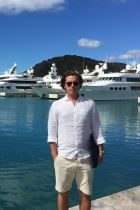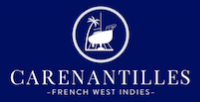
Tucked into the well-protected Le Marin Bay on Martinique, Carenantilles shipyard is forging a sterling reputation thanks to captains' word of mouth recommendations.
Arthur de Lucy's father had the early vision to bring the yachting industry to the bay, positioning the shipyard at the forefront of Martinique's development as a boating destination for the past 25 years. Today, under the leadership of Arthur de Lucy, with significant investment in renovations and new 80T and 440T travelifts, the ambition is to become the shipyard of choice for superyachts in the Southern Caribbean whether for maintenance work or a complete refit.
OnboardOnline: Carenantilles Shipyard is a family business that your father started 25 years ago – tell us a little about the history.
Arthur de Lucy: My father started in the yachting industry in Martinique in 1978 when he opened a small ship chandler in Fort de France. In fact, he bought a sailing yacht from Camper & Nicholsons to sail the Caribbean but there were no facilities to do maintenance work in the area so he started it himself!
He opened the first shipyard in Le Marin with the support of the city mayor, a close friend, who shared his vision for the development of the yachting industry in the Bay of Marin, which is one of the most beautiful and safest in Martinique, if not in the Caribbean.
OO: When did you join the business and was it always what you wanted to do?
AL: Well, I was born on a small island off Martinique, so boats have been part of my life since the beginning, coming to the yard every spare moment to look at the boats and cranes.
The final decision to return to the family shipyard came during my graduate studies. My family has been in Martinique for three centuries, it was always obvious that I would return to Martinique after my studies. I’m an only child and I see this business as my passion and an opportunity. It happened quite naturally. I didn't even need to talk to my father, it made sense that I came home.
I had studied at engineering school in France and then at business school in Nice I had a number of internships in the yachting industry. So I had been preparing myself for this career.

55m M/Y Driftwood at berth
OO: When did you take over the management of Carenantilles and what does your role entail?
AL: I took over the management of Carenantilles in 2016. I take care of all the operational side, the management of the fleet of machines, human resources and development geared towards making the yard more attractive to superyachts.
OO: You must have seen some changes in the shipyard, and in Martinique, over the past 10 years?
AL: In 10 years the number of yachts has grown considerably, but also the size of the boats. At the time, 50-foot boats were big, now it's almost the smallest we get out of the water!
In 2015, the yard entered a new era with a total renovation. This was also when I came to work here permanently. In the process, we listened to market demand and invested in two new travelifts - 440T and 80T.
The 5-acre site is laid in concrete and is equipped with a water treatment system, which is unique in the Caribbean. We're proud to comply with all European environmental standards.

Arthur with his father who founded Carenantilles Shipyard
OO: By all accounts, the Caribbean has had a great winter season with the number of returning yachts back up to levels prior to Hurricanes Maria and Irma – is this having a knock-on effect at the shipyard?
AL: Indeed, we had a very good season, the Caribbean is a strong yachting hub, despite the hurricanes. Of course Martinique is ideally located in the heart of the Caribbean arc and it's always reassuring for captains to know they have a quality technical stop in the centre of their sailing area.
After the hurricanes, we increased our berths to accommodate boats from the north. We also repaired several boats that had been damaged in the hurricanes. But lluckily Martinique itself was not touched, the yard was completely unaffected. Being based in Marina du Marin, we're very protected from the sea and the tides. The shipyard is placed in a hurricane hole at the end of the bay, and around four acres of mangrove protect us from the sea.
To protect boats from the wind we weld the boat stands together to make a real cradle and we also anchor the boats with concrete blocks to ballast them. We also work in close collaboration with major naval insurance companies on new standards and new techniques.

The team at Carenantilles
OO: What proportion of your business comes from yachts based year-round in the Caribbean and the US?
AL: We are still in the early stages of development in the yachting industry and it's difficult to establish true statistics. Let's say rather that attendance has doubled each year for the last three years, and captains are happy with our services. Le Marin Bay, where Carenantilles shipyard is located, is also the point of arrival for DYT and Sevenstar yacht transports from Europe, so we are on the front line to welcome them and prepare them for departure every season.
OO: What services does Carenantilles offer and what type and size of vessel do you cater for?
AL: We offer all the services needed for quick repairs up to a complete refit of yachts up to 50 metres long.
We also offer a project management service and crew concierge services: provisioning, car hire, villa rental.
Our small 80-ton travelift handles around 1,000 boats up to 20m every year.
Our large 440-ton travelift handles, on average, one vessel over 20m per week.

The 440-ton travelift in action
OO: How many people work at Carenantilles and what specialities do you provide in terms of craftsmanship?
AL: The shipyard employs about 80 people. Fifteen are in charge of the handling, the dock and security, and the rest are distributed in the workshops.
The majority of the craftsmen are independent companies whom we have selected with care. We constantly have reason to admire the quality of their work and the deadlines they're able to meet.
There are 14 workshops onsite covering all trades (electricity, mechanics, fibreglass, carbon, carpentry, sailing, saddlery, painting, rigging, electronics, surveyor, propeller repair). We also allow external teams to come in if the captains prefer.
OO: What’s the most common type of works carried out at Carenantilles?
AL: We are able to carry out all types of work.
Last year we did a complete painting on a 36m Benetti, repaired the rudders on sailing yachts of 45 and 47 metres, repaired the propeller shaft on a 45m motor yacht and a stabiliser on a 36m vessel. Our teams have greatly improved their working techniques and we respect all European quality standards here.
The most common jobs are, of course, hull cleaning and the application of antifouling.

Preparing to haul out S/Y Aurelius
OO: Do you collaborate with any other yards in the Caribbean?
AL: We have a longstanding partnership with the shipyard of Fort de France which operates a 180-metre-long dry dock and is in the middle of a renovation phase. I’m also trying to develop partnerships with shipyards and marinas on other islands.
It is always reassuring for captains to have a complete offer of services in the Caribbean. Several captains also ask us for advice in case they run into problems when they are off cruising.
OO: You recently carried out maintenance works for Contigo, the catamaran owned by Laura and Enrique of Mission Ocean – did you get to know them and hear about their project while they were in the yard?
AL: When Laura and Enrique arrived at the shipyard I didn't know about their project, but I recognized the sponsor, Monaco Marine, on their boat so that was a conversation starter. Indeed, I worked at Monaco Marine in La Ciotat for a few months to learn the basics of the yachting industry. So we did get to know each other, yes.
I greatly appreciated meeting Laura and Enrique and learning about Mission Ocean. We even organised a conference for them at the shipyard about the dangers of plastic in the marine environment. Respect for nature is essential if we want to continue enjoying these beautiful islands.
Carenantilles Shipyard is also undergoing ISO 14001 certification.

S/Y Atalante
OO: What’s your vision for Carenantilles – where do you want to take the business over the next five years?
AL: I think we can become the reference shipyard for superyachts in the Caribbean. I'm doing my best to make this happen. The captains who come to us are always very satisfied with the work done, we just need to become better known!
Yachting works by word of mouth. Work must be completed perfectly on every yacht and then your reputation spreads.

OO: What is the most important thing you’ve learned in your role so far?
AL: To be rigorous in the work and flexible in human relationships, but I still have a long way to go.
OO: Who do you most admire in the world of business/yachting, who has inspired or influenced you?
AL: Eric Tabarly, who I knew very well, and who confirmed my passion for the sea. He was one of France's greatest-ever yachtsmen who developed new techniques in the construction of ocean racing sailing yachts. His legacy lives on in some of today's greatest champions who trained by his side.
Eric was a family friend, his wife was one of my aunt's closest friends. Tragically, he died while sailing in the Irish Sea in 1998 en route to the Fife Regatta. I was still very young, but I have very good memories of Eric. He taught me to use a sextant!
OO: Which three objects would you take to your desert island?
AL: A fishing rod, a knife and my wife. (The order is very important!)
OO: What is your motto?
AL: "Sailing unmasks imposters. At sea, you either know or you do not." There is no place to hide. This is from one of Eric Tabarly's sayings, from his memoir, that became a French proverb: "Naviguer est une activité qui ne convient pas aux imposteurs. En bateau, on sait ou on ne sait pas."
Images: Arthur de Lucy/Carenantilles


Post your comment
You cannot post comments until you have logged in.
Login to post a commentComments
No one has commented on this page yet.
RSS feed for comments on this page | RSS feed for all comments